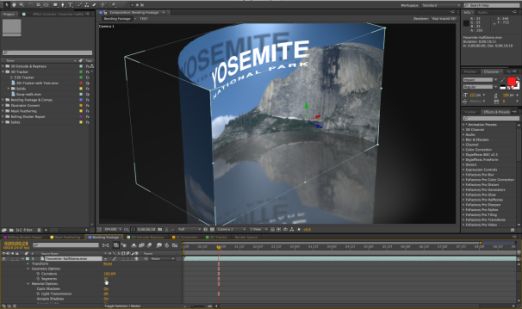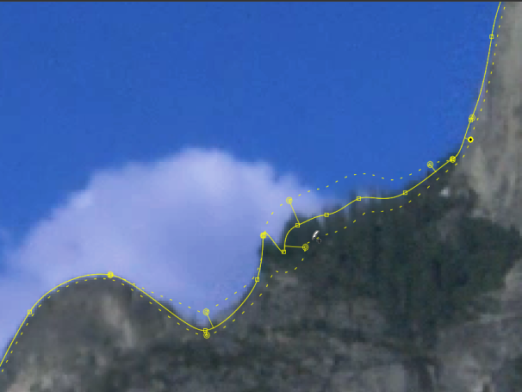The release of After Effects CS6 is proof that Adobe actually listens to customer requests and stays current with the needs of today’s filmmakers, editors, and motion graphics artists. Beyond this release’s impressive list of new features, there are much-needed and long-awaited performance improvements.
Adobe has implemented severalstructural developments like the newray-traced 3D rendering engine and Global Performance Cache that itrebuilt from the ground up, providing not only faster performance, butincreased professional capabilities. New tools such as the 3D CameraTracker, Rolling Shutter Repair, and variable mask edge feathering areserious professional compositing tools. The enhanced integrationbetween After Effects CS6 and other Adobe tools makes the workflowfaster and more fluid than before.
Greatlyimproved performance
The Global Performance Cache feature is the newfound powerunder thehood that makes After Effects CS6 perform better–even on older Macs.This is a set of technologies that work together: a global RAM cache, apersistent disk cache, and a new graphics pipeline.
The global RAM cache employs reusable frames recognized anywhere on thetimeline–not just adjacent frames–as well as duplicated layers orsub-comps. Cached frames are restored after an Undo/Redo operation,when layers are hidden or revealed, or when timeline settings return toa previous state. The feature allows users to experiment or “nudge”elements without a performance penalty should they change their mind oraccidentally hit something that would normally wipe out the RAM previewand force a re-render.
Selecting a dedicated solid state drive (SSD) on your system–whetheran internal drive on a tower or an external USB or Thunderboltdrive–to be used as your disk cache, will greatly boostperformancewithout further taxing your system hard drive. Additionally, this cachecontains frames from all projects you have opened in the same orearlier sessions, so disk cached frames from one project will beretrieved for reuse in other projects that use those same frames.
After Effects CS6 also better harnesses OpenGL and your video card,resulting in a more responsive and immediate playback of largecompositions–especially on larger displays. (Adobe says that earliertests by Nvidia yielded acceleration by a factor of 1.5 to 2.5 times,with some graphic functions being up to 16 times faster than before.)

The new ray-traced 3D featureallows you to bend comps and footage layers with added realism.
New 3D extrusions, bendable footage,and ray-tracing
Adobe has totally reworked the After Effects CS6 3Denvironment. Textand shape layers can now be extruded with beveled edges, and footageclips, images, and solid layers or even sub-comps can be bent in 3Dspace. And all 3D objects can interact with each other to cast shadows,reflections, transparency, specular and diffused light, and more.Ray-traced rendering enhances the 3D objects with much more realismthan ever before, with environment mapping and light refraction throughtransparent materials.
While these significant 3D enhancements have been made, it’s clear thatAdobe isn’t trying to compete in the 3D modeling or application space.The tools provided only generate some more realistic results withoutthe need to rely on third-party plug-ins for basic animations andmotion graphics, but you will still need something like Zaxworks to produce 3Delements featuring bump mapping and sophisticated texturing.
You can’t import 3D models with this release, nor will the Live 3Dlayers from Photoshop CS5.5 work with this new 3D environment: Theynever truly worked interactively with other 3D elements in previousversions, so no real loss there. I do wish Adobe would have included atleast some simple primitive shape objects to build on.
The ray-tracer replaces the older scanline-based Classic 3D renderer,which supports refined rendering of soft shadows, light falloff, DOF,motion blur, and project through lights. The specular highlights can beintensified and focused on any object, and reflections can displayfocus and blur for added realism.
Another huge leap into Creative Suite integration is the new Create Shapes From Vector Layer command, as applied to an imported Illustrator file. This allows you to import vector AI and EPS files with logos, artwork, and designs, and convert them to editable shape layers in After Effects CS6. You can manipulate the fill and stroke colors, edit the shapes, and apply shape operators including Wiggle Paths and Wiggle Transform. And since shapes can now be extruded in 3D, you can create animated, dimensional logos right inside of After Effects CS6.
Variablemask edge feathering
As a compositor, I find the new variable mask edge featheringfeatureextremely useful and something I’ve been waiting for. You can applythen new Mask Feather Tool to any segment of a closed mask path, whichcreates handles that can be adjusted to determine the amount offeathering along the path in those regions. This means that a singlepath can now be modified to accommodate both hard and soft edgesurfaces such as motion blur in a moving object. In earlier versions ofAfter Effects, users would have to create multiple masks and stack themto obtain variable edge feathering, which is not only more tedious, butmakes animating the paths over time a painful experience. With the MaskFeather Tool, the individual points can also be keyframed along thetimeline and adjusted with the object being masked.
Morehelp for DSLR footage
With the release of After Effects CS5.5, Adobe introduced theWarpStabilizer, which analyzes footage data and does an incredible job ofstabilizing handheld and shaky rig footage. This has been an importanttool for emerging DSLR shooters who are nowproducing a lot of handheldvideo. Yet a problem that occurs with footage shot on digital cameraswith a CMOS sensor is the Rolling Shutter or “jello-cam” effect–wherethe vertical scan of the sensor can’t keep up with the movement of thecamera, especially in side-to side panning. After Effects CS6introduces the Rolling Shutter Repair effect that analyzes the footageand generates a corrective result. It works using one of twouser-selectable algorithms, Warp or Pixel Motion, and a choice of scandirections, depending on the angle of the camera during shooting. Theeffect can also be keyframed on the timeline to fine-tune theadjustments and keep from over-correcting when applied to a footageclip globally.

Variable edge mask feathering isnow possible, which greatly helps when creating masks or roto work onobjects with multiple types of edges.
I found this effect worked well in most cases, but it’s not a cure forall footage. In the case of a smaller-chip camera like the GoPro sportscamcorder, the jello-cam effect caused by vibrations or rapid shakingof the camera can’t be fixed by the Rolling Shutter Repair because thedistortions are moving in all directions.
3DCamera Tracker takes you into your shot
The new 3D Camera Tracker effect automatically analyzes themotion inyour 2D video footage and computes the position, orientation, and fieldof view of the real camera that shot the scene, and creates a new 2Dcamera in After Effects CS6 to match the original footage. The resultis a 3D camera to which you can applytext, solid/null, andshadow-catcher layers to a target point you assign with triangulatedpoints from the tracking point cloud.
I was actually quite surprised at the results when I tried it on somehand-held footage I shot while walking–complete with a lot of camerashake. The 3D Camera Tracker followed the original camera movementsamazingly well and with the addition of some motion blur, the resultswere pretty impressive.
You can hover the cursor over the point cloud in the analyzed clip andalign the target with the plane to which you wish to attach your textor solid/null layers. You can select more than the three automaticallychosen points by shift-clicking additional points on the cloud untilthe target is precisely where you want it. Then, right-clicking on thetarget lets you create your desired 3D layers and camera. In my test, Ialso added a Shadow Catcher layer so the lights I used on the 3Dextruded text would cast a shadow on the wall it was attached to andprovide more realism.
What this feature doesn’t do well is keep track of points that move outof frame, so your footage either has to be quite short if the camera isin motion such as walking, or if you are panning more than about 60degrees. For those shots, you’d be better off using a planar trackersuch as Mocha AE, which ships with After Effects CS6 and offers a muchimproved Mocha AE workflow. This stand-alone software allows you toapply planar tracking to position inserted objects and createper-vertex feathering on roto-splines as well as on the Mocha Shapemasks.
Furtherenhancements
Previously available as a separate product from AutomaticDuck, the newPro Import After Effects is an integration tool that lets you easilyimport video into After Effects CS6 from other programs. It works withAvid Media Composer and Symphony AAF/OMF files, as well as with XMLfiles from Apple Final Cut Pro 7 or earlier. Many of the translationsof supported Avid and Apple files include position, scale, rotation,keyframes, composite mores, titles, speed changes, and more. Pro ImportAfter Effects ships with After Effects CS6.
There are more than 80 new and updated built-in effects with thisrelease, including the CycoreFX HD Suite, which supports16-bit-per-channel color, while 35 of them support 32-bit floatingpoint processing. This increases the color depth and reduces bandingand other artifacts previously created by lower-resolutioneffects–especially noticeable when color correction is further applied.
There are some new effects in this suite that were not previouslybundled with After Effects, such as Cross Blur, Color Neutralizer,Kernel, Threads, Environment, Rainfall, Snowfall, Block Load, Plastic,Line Sweep, WrapoMatic, and Overbrights. There are also enhancementssuch as support for motion blur and composition’s 3D lights in therelevant CycoreFX effects.
The ability to import native ARRIRAW footage from ARRIFLEX D-21 orALEXA digital cameras is also new to After Effects CS6. There is nownative support for Adobe SpeedGrade .Look files, cineSpace .csp files,and overrange IRIDAS .cube files. Added to the existing support for REDR3D files, XML, and DPX sequences, this makes After Effects CS6 a trulyintegral part of a professional filmmaker’s workflow.
Buyingadvice
If you held out updating After Effects from CS5 or earlier, Iurge youto consider this upgrade–or get left in the dust. That sounds like astrong statement, but I believe it’s justified. After Effects CS6 isthe most important upgrade the program has received since the firstmajor update in version 7. It’s not just a bunch of additional featuresand add-ons, but rather a truly rebuilt, reworked, and enhancedpowerful compositing and motion graphics creation tool.
While I’d still like to see some basic primitive shape objects added tothe new 3D ray-trace enviroment, and there’s definitely room forimprovement with the Roto Brush tool that was introduced in CS5, theenhancements in CS6 have answered the needs of professionals in today’sfilm industry. And with the insanely affordable upgradeoptions–or thenew Creative Cloud subscription–there’s no reason to pass up thisopportunity.




